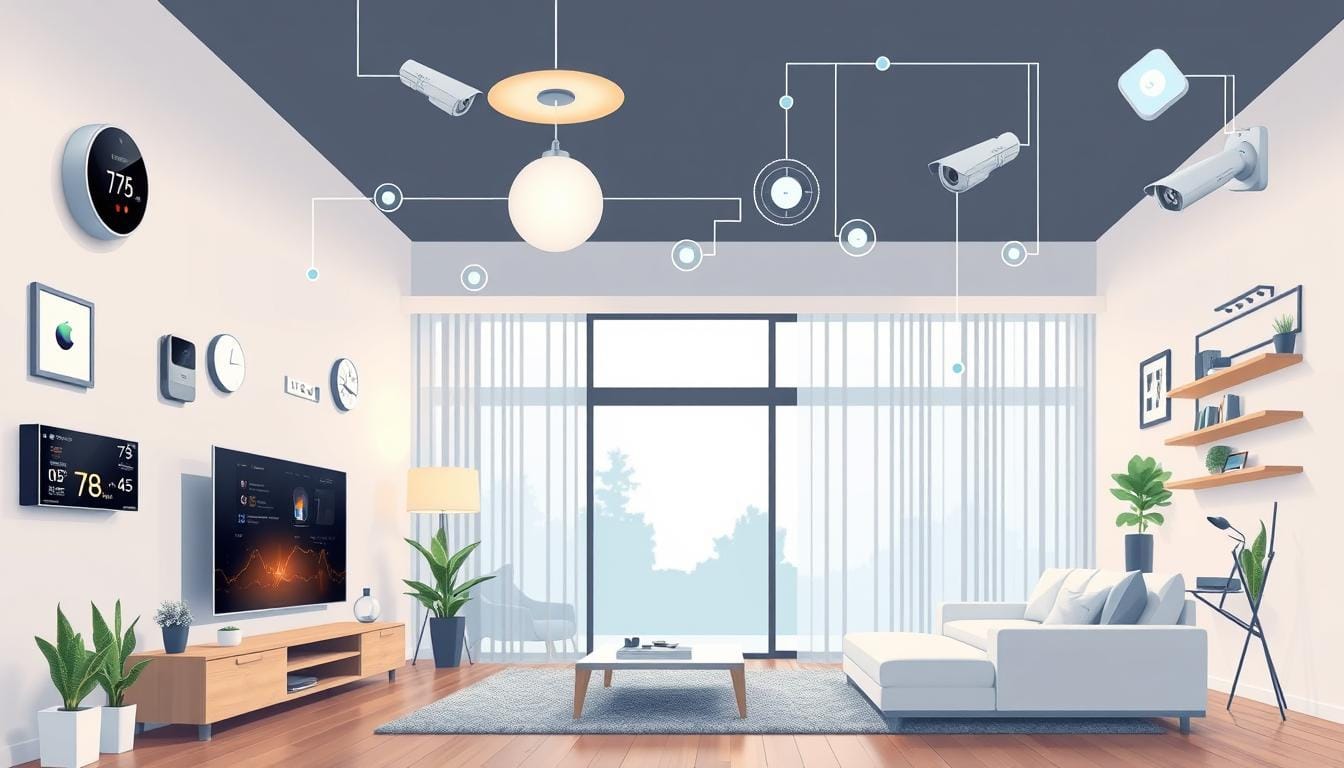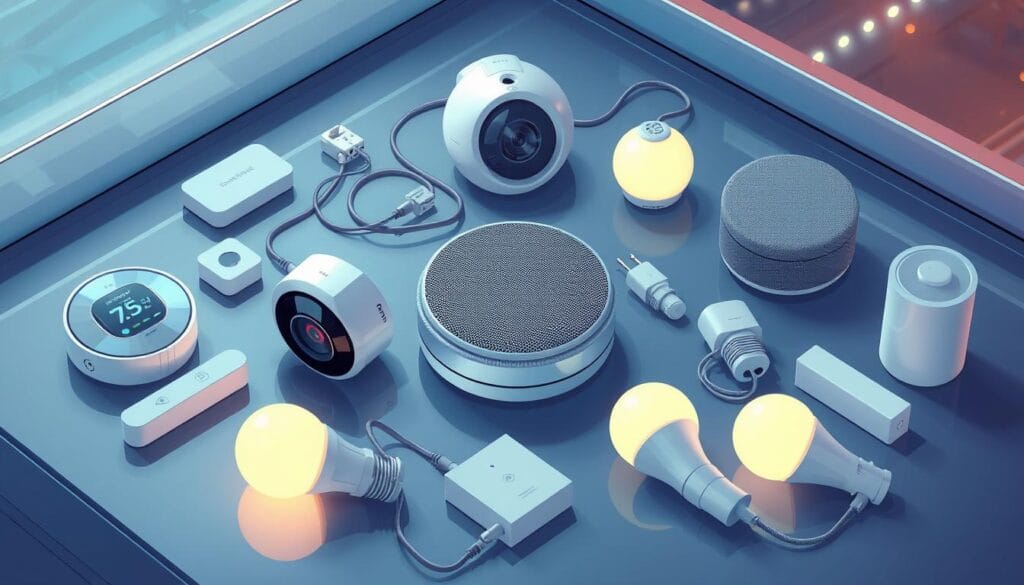What Part of a Smart Home Breaks Things Apart? Exploring the hidden Issues
January 20, 2025 | by hiliga24


When thinking about a smart home, you might ask What Part of a Smart Home Breaks Things Apart? A smart home has many parts, like thermostats, lights, and security systems. Knowing these parts helps us understand why smart homes can go wrong.
People often wonder what makes a smart house and what stops them from being smart. The answer is the complexity of these systems and the chance for technical problems.
Recent studies show that by 2030, about 500 billion devices will use sensors and connect to the internet. This growth in IoT technology makes it easier for hackers to target our homes. So, it’s key to learn how to keep our smart homes safe from cyber threats.
Key Takeaways
- Understanding the components of a smart home is crucial to identifying the reasons for smart home failures.
- The complexity of smart home systems can lead to technical issues and barriers to implementation.
- Protecting your smart home from hackers is essential due to the increasing sophistication of IoT technology.
- Regular maintenance and appropriate repair methods can minimize substantial repair costs.
- Approximately 500 billion devices are projected to utilize sensors and establish internet connectivity by the year 2030.
- 70% of all internet-connected devices are vulnerable to potential attacks, according to a study by Hewlett-Packard.
- AI-driven solutions can enhance security without overwhelming the limited resources of IoT devices.
What Part of a Smart Home Breaks Things Apart: Understanding the Essential Components

A smart home system connects devices for convenience, energy savings, and security. At its heart is smart home technology that lets devices talk to each other and be controlled from afar. This tech is at risk of smart home hacked attacks, so smart home cybersecurity is key.
The internet of things (IoT) is vital in smart homes, enabling devices to connect and work together. A smart home usually has smart thermostats, lighting, and security systems. These are managed through a smart home system hub, the main control unit.
Core Smart Home Infrastructure
The heart of a smart home is its devices and systems. This includes the hub, devices, and how they connect, like Wi-Fi or Ethernet. A strong, secure connection is crucial to stop smart home hacked attempts and keep devices talking smoothly.
Key Smart Home Devices and Their Functions
Important smart home devices are smart thermostats, lighting, and security systems. They can be managed from a phone app or voice assistant, offering ease and energy savings. For instance, smart thermostats adjust the temperature based on your habits, and smart lights turn off when you leave.
The Role of Hub Systems and Controllers
A hub system or controller is the brain of a smart home. It connects and controls all devices, ensuring smooth communication and control. Popular hubs like Control4 and Josh.ai offer reliable performance and easy use. They let homeowners control their devices with voice commands or apps, making smart home management simple.
What Part of a Smart Home Break Things Apart: Common Failure Points

Identifying common failure points in smart home breakdowns is key for smart home troubleshooting. Studies reveal that smart homes sometimes face bugs, no matter their cost or complexity. The more complex a system, the higher the chance of malfunctions or system failures.
Smart speakers, cameras, and thermostats are often the first to fail, with rates of 21%, 19%, and 17%, respectively. Also, 35% of users face a device issue within a year. To avoid smart home malfunctions, focus on devices with local control, lessening cloud connection needs.
Regular upkeep and smart home troubleshooting help prevent issues. Try disconnecting modems, hubs, and routers to check device work during outages. Knowing common failure points and acting early can make your smart home more reliable and efficient.
Using devices that follow universal standards, like Matter, boosts compatibility and lowers smart home breakdowns risk. Being informed about these failure points and taking preventive measures can lead to a smoother, more efficient smart home experience.
Critical Barriers to Smart Home Implementation
Smart home maintenance can face several common issues. These include failures in smart home components. Fixing these devices can be tough, mainly due to technical limits and compatibility problems.
Network infrastructure issues are a big challenge. They can harm the performance of your smart home system. Knowing the technical needs and limits of smart home devices is crucial.
Being aware of these issues helps prevent them. Regular maintenance, software updates, and troubleshooting are key. This way, you can enjoy your smart home while avoiding component failures.
Some common problems to watch out for include:
- Incompatible devices
- Network connectivity problems
- Software glitches
By being proactive and fixing these issues quickly, your smart home will work well. It will keep running efficiently and effectively.
The Internet of Things (IoT) and Its Impact on Smart Home Reliability
The Internet of Things (IoT) has changed how devices talk to each other in smart homes. It lets you control and watch your home’s systems from anywhere. With over 27 billion IoT devices expected by 2025, knowing its pros and cons is key.
IoT makes life easier in smart homes. For example, smart home devices can cut energy costs by about 15%. This means the average homeowner can save $180 a year. Also, 80% of smart home users say they have better control over their homes.
But, IoT can also cause smart home technical problems and smart home technology problems. Having a detailed smart home troubleshooting guide is vital. It should help fix common issues like smart home device malfunction and show how to get the most from IoT.
Some important stats to think about include:
- 70% of homeowners find smart home devices more convenient
- 45% of homeowners use smart security systems for safety
- Insurance companies give discounts of 5% to 20% for smart homes
In summary, IoT has greatly changed smart homes, bringing both benefits and challenges. By understanding IoT’s effects and having a good troubleshooting guide, you can enjoy a more convenient, efficient, and safe home.
Smart Home Security Vulnerabilities
When you buy smart home devices, think about the security risks. Smart home tech has grown, and so have worries about data leaks and privacy. About 63% of smart home users fear data leaks. Also, about 80% of US consumers worry about smart home devices, mainly about data security and privacy.
To keep your smart home safe, follow some key tips. Update your devices regularly and use strong passwords. Getting smart home support is also key to keeping your devices secure. But, many smart home devices can be attacked, with about 40.8% of smart homes worldwide having vulnerable devices.
To lower these risks, use smart home hubs like Apple HomeKit and Samsung SmartThings. They offer better security, like two-factor authentication and end-to-end encryption. Also, segmenting your home network and using multi-factor authentication can boost security a lot.
By doing these things, you can lower the chance of smart home problems. Always focus on smart home support and upkeep. This will help protect your devices and data from threats.
Protecting Your Smart Home System from Cyber Threats
To keep your smart home safe from cyber threats, you need strong security measures. This means fixing smart home problems by finding and fixing weak spots. A good smart home repair guide helps you solve issues quickly.
Keeping your smart home in good shape is key to avoiding cyber threats. This means troubleshooting smart home technology and making sure all devices have the latest security updates. By troubleshooting smart home devices, you can spot and fix security risks early.
Essential Security Protocols
- Use strong, unique passwords for all devices and accounts
- Enable two-factor authentication (2FA) whenever possible
- Keep all devices and software up-to-date with the latest security patches
- Use a reputable antivirus program to protect against malware
Regular Maintenance Requirements
Regular upkeep is crucial to avoid cyber threats. This includes watching device activity, updating software and firmware, and doing regular security checks.
Software Update Best Practices
To keep your smart home safe, follow the best practices for software updates. This means installing updates right away, checking if they’re real, and watching your devices after updates.
Troubleshooting Smart Home Technology Failures
When your smart home component fails, it’s key to tackle the problem step by step. First, find out which device isn’t working and check its connections. If it still doesn’t work, try restarting it or updating its software. For tougher problems, look at the user manual or reach out to the maker’s support.
Some common smart home devices malfunctioning issues include connectivity problems, software glitches, and hardware failures. Here’s how to fix them:
- Check the device’s power supply and ensure it’s properly connected
- Restart the device and check for software updates
- Consult the user manual or contact the manufacturer’s support team for further assistance
To diagnose smart home malfunctions, knowing your devices is crucial. You might want to take online courses or get help from a pro. Also, remember that smart home repair tips often involve simple steps like restarting or checking connections.
By following these tips and being proactive, you can reduce downtime and keep your smart home running smoothly. Always follow the maker’s instructions and be careful when fixing or replacing devices.
Future-Proofing Your Smart Home Setup
Investing in your smart home means thinking about the future. It’s key to diagnose smart home breakdowns and fix common smart home problems early. A good smart home maintenance guide helps you stay ahead of issues, keeping your system efficient and safe.
Understanding your smart home’s setup is crucial for fixing smart home issues. Know how devices work together and make sure your network is strong. Being proactive with maintenance reduces downtime and keeps your system running smoothly.
Scalability Considerations
To make your smart home future-proof, think about these scalability factors:
- Device compatibility and integration
- Network infrastructure and bandwidth
- Power consumption and energy efficiency
By focusing on these, you can build a smart home that grows with you, is efficient, and secure.
Emerging Technologies and Standards
Keeping up with new smart home tech and standards is essential. Stay informed about trends like voice control and AI in home automation. Adopting these innovations makes your smart home modern, efficient, and easy to use.
Conclusion: Building a Resilient Smart Home Environment
As smart homes grow, making them reliable and secure is key. Fixing common problems helps create a better smart home. Regular upkeep, updates, and watching your network are essential.
Use separate networks, strong passwords, and check for threats often. This keeps your smart home safe from new cyber dangers. With a strong smart home, you enjoy its benefits without trouble.
FAQ
What is the component of a smart home?
A smart home has several parts. The core infrastructure is the base. Then, there are key devices like smart appliances and lighting. These devices automate and control the home.
The hub systems and controllers are the brain of the home. They manage and coordinate all the smart home components.
Why did the smart home fail?
The smart home has faced many challenges. Technical issues and compatibility problems between devices are big hurdles. Network infrastructure problems also play a role.
These barriers make it hard for some to set up and keep a smart home running smoothly.
What would a smart house have?
A smart house has many connected devices and systems. This includes smart appliances, lighting, and security systems. It also has HVAC controls and entertainment systems.
These components work together through a central hub or home automation platform. This allows for remote access and automated scheduling. It also helps optimize energy usage and other household functions.
What are the barriers to smart homes?
The main barriers to smart homes are technical issues and compatibility problems. Network infrastructure problems also pose a challenge.
These obstacles make it tough for homeowners to fully integrate and maintain a smart home system.
How to protect your smart home from hackers?
To keep your smart home safe from hackers, start with strong passwords and two-factor authentication. Regularly update your devices and network.
Also, watch out for common hacker entry points. This includes unsecured networks and vulnerabilities in your devices.
RELATED POSTS
View all


